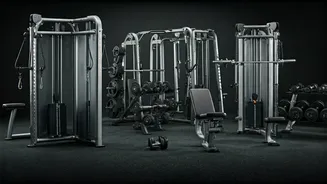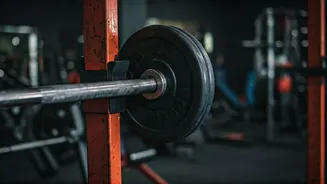Free Weights: The Classic
Free weights, encompassing dumbbells, barbells, and kettlebells, provide a foundational approach to strength training. Their inherent nature demands greater
control and coordination. Engaging multiple muscle groups simultaneously, free weights promote functional fitness. Users are constantly stabilizing and balancing the weight, which enhances overall body awareness and muscle activation. This leads to efficient calorie burning and improved core strength. However, free weights can pose a steeper learning curve for beginners due to the need for proper form. The risk of injury is higher if one doesn't utilize proper technique, and it necessitates careful supervision or self-monitoring to prevent mishaps. Space requirements and potential costs for equipment are also factors to consider. This method is often preferred by seasoned lifters seeking maximum muscle engagement and progressive overload.
Machines: Guided Strength
Workout machines offer a guided and often user-friendly exercise experience. Their design typically involves a fixed plane of motion, which helps isolate specific muscle groups. This isolation minimizes the need for stabilization, making them appealing to beginners. Machines guide the user through the movement, reducing the risk of injury associated with improper form. This structured design can be particularly beneficial for those recovering from injuries or needing more controlled movements. The convenience of machines lies in their adjustability and ease of use, often with clear instructions. Despite these advantages, machines sometimes limit the range of motion. This might restrict the natural movements that are common in everyday life. The isolated muscle engagement may not be as effective for building overall functional strength. Furthermore, the reliance on machines might reduce the development of essential stabilizer muscles. Space can also become an issue because some gyms have a variety of machines.
Cables: Versatile Training
Cables offer a versatile training option, bridging the gap between free weights and machines. The constant tension provided by cables keeps the muscles engaged throughout the entire range of motion, which is crucial for building endurance and strength. This constant tension allows for a more varied workout. Cable exercises can be tailored to target multiple muscle groups and functional movements. One of the main benefits is the ability to easily adjust the weight and resistance, making them suitable for all fitness levels. Cables provide a wide variety of exercise options due to the different attachments available. Users can experiment with different exercises. Cable exercises often require significant core engagement for stability, which leads to improved core strength. However, cable exercises might need a greater focus on form and control to maximize effectiveness and minimize the risk of injury. Also, the selection of cable machines available can impact your workouts because of space or design limitations.
Choosing Wisely
Ultimately, the best workout method hinges on individual fitness goals, preferences, and experience levels. Beginners often find machines appealing for their guided motions and safety features. As proficiency grows, incorporating free weights can help maximize strength and functional fitness gains. Cables provide a flexible option to add variety and improve muscle engagement throughout the motion. A well-rounded approach might incorporate all three methods. Combining them optimizes training benefits and avoids plateaus. Assessing needs, understanding the advantages and limitations of each method, and potentially seeking guidance from fitness professionals will lead to a plan tailored for success. This customized strategy will likely lead to a fulfilling fitness experience.














